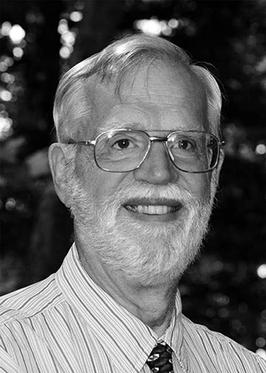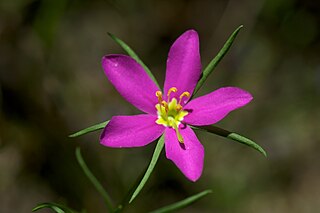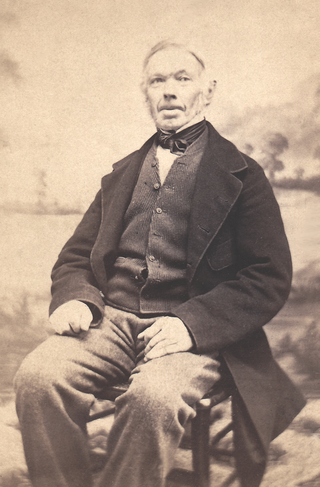Related Research Articles

William Roxburgh FRSE FRCPE FLS was a Scottish surgeon and botanist who worked extensively in India, describing species and working on economic botany. He is known as the founding father of Indian botany. He published numerous works on Indian botany, illustrated by careful drawings made by Indian artists and accompanied by taxonomic descriptions of many plant species. Apart from the numerous species that he named, many species were named in his honour by his collaborators.
Royal Botanical Gardens (RBG) is headquartered in Burlington owning extensive environmental protection areas, historic sites and culturally relevant gardens in Hamilton, Ontario, Canada. It is one of the major tourist attractions between Niagara Falls and Toronto, as well as a significant local and regional horticultural, education, conservation, and scientific resource. The mandate is derived by a Provincial Act of 1941 centred on human interaction with the natural world and protection of environmentally significant lands that form the western tip of Lake Ontario. Royal Botanical Gardens spans an area of about 10 km by 4 km, dominated by two coastal wetlands, and glacial-carved landscapes that extend from the lake up to the Niagara Escarpment plateau. The various gardens and natural areas are accessed through nine public entrance locations. It is one of several Prescribed Public Bodies listed under the Ontario Heritage Act.

The genus Macrocarpaea, with 105 species and two hybrids of 0.5 m herbs, shrubs, epiphytes and small trees to 10 m tall, is the largest genus of the tribe Helieae of the gentian family (Gentianaceae). Species of Macrocarpaea have diurnal and nocturnal pollinators, visited during the day by hummingbirds, insects and butterflies, and at night by bats, moths and many different kinds of insects. The common name for the genus is 'Moon-gentian'. No species are known in cultivation.

John Gilbert Baker was an English botanist. His son was the botanist Edmund Gilbert Baker (1864–1949).

Professor David John Mabberley, is a British-born botanist, educator and writer. Among his varied scientific interests is the taxonomy of tropical plants, especially trees of the families Labiatae, Meliaceae and Rutaceae. He is perhaps best known for his plant dictionary The plant-book. A portable dictionary of the vascular plants. The third edition was published in 2008 as Mabberley's Plant-book, for which he was awarded the Engler Medal in Silver in 2009. As of June 2017 Mabberley's Plant-book is in its fourth edition.

James Lauritz Reveal was a U.S. botanist best known for his contributions to the genus Eriogonum and for his work on suprageneric names. His website, at PlantSystematics.org, also presents material on plant taxonomy including the Reveal system. He published extensively on North American flora, was a member of the Angiosperm Phylogeny Group, and was one of the authors of the APG II and APG III classifications.

Randall James Bayer is an American systematic botanist born in Buffalo, New York, who spent his childhood in East Aurora. He earned a B.Sc. with major in plant breeding and minor in horticulture in 1978 from Cornell University; an M.Sc. in systematic botany in 1980 from the Ohio State University; and a Ph.D. in 1984 from the Ohio State University with the dissertation Evolutionary Investigations in Antennaria. His interest in the genus Antennaria was inspired by noted evolutionary botanist George Ledyard Stebbins (1906–2000) who was a visiting professor at the Ohio State University in 1978–1979.

Sabatia arkansana, commonly known as Pelton's rose gentian, is an herbaceous annual in the gentian family. It was discovered in 2001 in several glades of the Ouachita Mountains in Saline County, Arkansas by John Pelton, a retired mechanic turned amateur photographer and naturalist. It is known only from two locations in this county and is considered critically imperiled as a result of the presence of nearby housing developments and due to the absence of a fire regime. In summer it shows attractive rose-purple flowers.

Cardiopteridaceae is a eudicot family of flowering plants. It consists of about 43 species of trees, shrubs, and woody vines, mostly of the tropics, but with a few in temperate regions. It contains six genera, the largest of which is Citronella, with 21 species. The other genera are much smaller.

Eduard August von Regel, Russian: Эдуард Август Фон Регель; was a German horticulturalist and botanist. He ended his career serving as the Director of the Russian Imperial Botanical Garden of St. Petersburg. As a result of naturalists and explorers sending back biological collections, Regel was able to describe and name many previously unknown species from frontiers around the world.
Loren H. Rieseberg is a Canadian-American botanist.

Sherwin John Carlquist FMLS was an American botanist and photographer.

John Goldie was a Scottish-born botanist and author. He is credited with recording the existence of fourteen plant species previously unknown to science including Dryopteris goldieana, Stellaria longipes and Drosera linearis.

John McNeill is a British and Canadian botanist and museum director who has worked particularly on the plant order Caryophyllales. In 1960, he received a Ph.D. from the University of Edinburgh for his thesis on “Taxonomic studies in the Alsinoideae”. As a nomenclature specialist, he has provided editorial guidance for journals and book series, and has served as a member of the Editorial Committee of the International Code of Botanical Nomenclature and the International Code of Nomenclature for algae, fungi, and plants since the XIII International Botanical Congress in 1981. He has served as Vice-rapporteur and Rapporteur-general for several botanical congresses, including at Melbourne (2011). As an editor for the journal Taxon, he is involved with assessing proposals to conserve and reject botanical names.
George Hill Mathewson Lawrence was an American botanist, writer and professor of botany who helped establish the 'Liberty Hyde Bailey Hortorium', the Hunt Botanical Library and the Huntia journal. He was also an avid book collector, including books on the history of Rhode Island, historic books and botanical art.
Yojiro Kimura was a Japanese botanist, known for his classification of monocotyledons, and of Japanese species of Hypericum.
Jan Salick is an American botanist who researches the interaction between humans and plants (ethnobotany) and conservation biology. Her specialisms include alpine environments, climate change, indigenous peoples and traditional knowledge. She is a past-president of the Society for Economic Botany and holds their Distinguished Economic Botanist award. She is also Fellow of the American Association for the Advancement of Science and received the Fairchild Medal for Plant Exploration. In 2019 she retired as Senior Curator of Ethnobotany at the Missouri Botanical Garden, and now has emerita status.
Brian Morey Boom is an American botanist who specializes in the flora of the Guianas and the Caribbean, the family Rubiaceae, ethnobotany, and economic botany.
John Cameron Semple is a botanist, cytotaxonomist, professor emeritus, and adjunct professor at the University of Waterloo in Ontario, Canada. He was born in Boston and earned a degree of Bachelor of Science in 1969 from Tufts University, followed in 1971 and 1972 by Master of Arts and Doctor of Philosophy degrees from Washington University in St. Louis. Semple is known for his work with members of the tribe Astereae, particularly goldenrods, American asters, and goldenasters, and he maintains the University of Waterloo Astereae Lab website. Semple's wife is Brenda, and in 2013, he named a newly-discovered goldenrod species Solidago brendiae in honor of her.
John James Pipoly III is an American botanist and plant collector. He is a leading expert on the systematics and taxonomy of the genus Ardisia within the Myrsinoideae, as well as the family Clusiaceae.
References
- ↑ Laking, L. 2006. Love, Sweat and Soil: A history of Royal Botanical Gardens from 1930 to 1980. Royal Botanical Gardens Auxiliary. Burlington, Ontario.
- ↑ James Scott Pringle on WikiSpecies
- ↑ "Associate & Adjunct – Department of Biology". Archived from the original on 2018-08-19. Retrieved 2017-04-03.
- ↑ Grant, J. R. 2004. Harvard Papers in Botany (Vol. 9, No.1)
- ↑ S. K. Dey, S., K., D. Maity. 2015. Edinburgh Journal of Botany Publication date: November 2015. DOI: https://dx.doi.org/10.1017/s0960428615000189
- ↑ International Plant Names Index. J.S.Pringle.